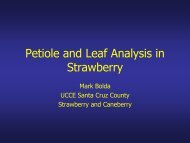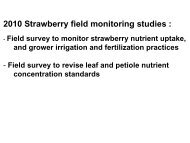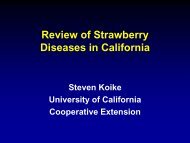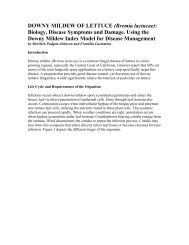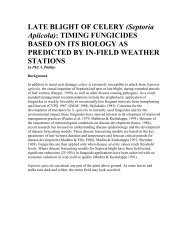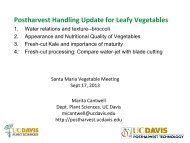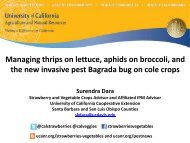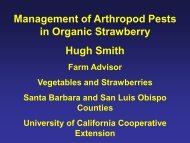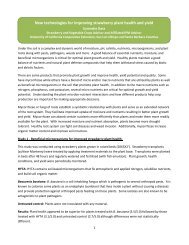Recent Progress in our Understanding of Verticillium wilt of Lettuce
Recent Progress in our Understanding of Verticillium wilt of Lettuce
Recent Progress in our Understanding of Verticillium wilt of Lettuce
You also want an ePaper? Increase the reach of your titles
YUMPU automatically turns print PDFs into web optimized ePapers that Google loves.
<strong>Recent</strong> <strong>Progress</strong> <strong>in</strong> <strong>our</strong><br />
Understand<strong>in</strong>g <strong>of</strong> <strong>Verticillium</strong> <strong>wilt</strong><br />
<strong>of</strong> <strong>Lettuce</strong><br />
Krishna V. Subbarao<br />
Department <strong>of</strong> Pathology<br />
University <strong>of</strong> California, Davis
<strong>Verticillium</strong> Wilt <strong>of</strong> <strong>Lettuce</strong>
LETTUCE<br />
PRODUCTION<br />
Year-round <strong>in</strong> CA:<br />
• Imperial Valley<br />
production<br />
• San Joaqu<strong>in</strong> Valley<br />
(seed)<br />
• Coastal production<br />
<strong>Verticillium</strong> Wilt <strong>of</strong> <strong>Lettuce</strong>
<strong>Verticillium</strong> Wilt <strong>of</strong> <strong>Lettuce</strong><br />
VERTICILLIUM WILT<br />
Foliar Symptoms:<br />
• Angular Chlorosis<br />
• Necrosis<br />
• Wilt<strong>in</strong>g<br />
• Darken<strong>in</strong>g <strong>of</strong> Leaf Ve<strong>in</strong>s<br />
• Acropetal <strong>Progress</strong>ion<br />
• Collapse <strong>of</strong> Head
<strong>Verticillium</strong> Wilt <strong>of</strong> <strong>Lettuce</strong><br />
VERTICILLIUM WILT<br />
Root Symptoms:<br />
• Vascular Discoloration<br />
• Occur ~2 wk before<br />
foliar symptoms
<strong>Verticillium</strong> Wilt <strong>of</strong> <strong>Lettuce</strong><br />
• Caused by V. dahliae<br />
– Conidia<br />
– Microsclerotia<br />
– No known sexual stage<br />
• Cross-pathogenic<br />
– Artichoke<br />
– Strawberry<br />
– Solanaceous crops<br />
– Non-domesticated plants<br />
• Seedborne<br />
(Vallad et al. 2005)
<strong>Verticillium</strong> Wilt <strong>of</strong> <strong>Lettuce</strong><br />
<strong>Verticillium</strong> <strong>wilt</strong> development<br />
≤ 2 Weeks<br />
Possible Short-term Solution:<br />
Harvest Early<br />
Post-Harvest Quality?
<strong>Verticillium</strong> Wilt <strong>of</strong> <strong>Lettuce</strong><br />
NO RELATIONSHIP BETWEEN<br />
DI AND PH QUALITY<br />
Marketability<br />
1.0<br />
0.8<br />
0.6<br />
0.4<br />
0.2<br />
0.0<br />
R = 0.040<br />
P (0.05) =<br />
0.6989<br />
0.0 0.2 0.4 0.6 0.8 1.0<br />
Disease Incidence<br />
• Across all lettuce types and three <strong>in</strong>dependent experiments
<strong>Verticillium</strong> Wilt <strong>of</strong> <strong>Lettuce</strong><br />
Relative Marg<strong>in</strong>al Effects: Disease Severity<br />
1.0<br />
0.8<br />
0.6<br />
0.4<br />
0.2<br />
LaBrillante Sal<strong>in</strong>as Sniper<br />
4.5<br />
Avg.<br />
DS<br />
0<br />
0.0<br />
Control<br />
Ls3A<br />
LsWats3<br />
Fca23<br />
Ls336<br />
Cv85<br />
Ls16<br />
Ls1<br />
Ls476<br />
LsGH1<br />
Cv111<br />
Ls474<br />
Ls472<br />
Ls331<br />
Ls429<br />
Ls14<br />
Ls7<br />
Cs80<br />
Fca29<br />
Ca63<br />
Cf45<br />
Ls17<br />
Ls439<br />
Cf40<br />
St91<br />
Cultivar-Isolate <strong>in</strong>teractions<br />
(32 isolates x 4 cultivars x 3 reps. x 3 experiments)
<strong>Verticillium</strong> Wilt <strong>of</strong> <strong>Lettuce</strong><br />
Current Management Strategy:<br />
Rotate to Strawberry production…
114 Fields identified<br />
≈ 895 hectares <strong>in</strong>fested<br />
(2,210 acres)<br />
Sal<strong>in</strong>as<br />
Watsonville<br />
K<strong>in</strong>g City<br />
K<strong>in</strong>g City
FACTS<br />
• <strong>Verticillium</strong> dahliae is seedborne <strong>in</strong> lettuce<br />
and other crops and weeds.<br />
• It is both externally seedborne and<br />
<strong>in</strong>ternally seedborne.<br />
• Infested seed germ<strong>in</strong>ates, plants grow and<br />
develop <strong>wilt</strong>.<br />
• Seed harvested from <strong>in</strong>fected plants are<br />
<strong>in</strong>fested with V. dahliae.
Where produced (2008-09)?<br />
Country Seed lots Infested Range<br />
USA 179 33 0.5-5<br />
Ch<strong>in</strong>a 22 8 0.5-3<br />
Chile 29 5 0.5-2<br />
The Netherlands 5 0 -<br />
Australia 7 0 -<br />
Total 242 46
Verticilliate<br />
Conidiophores<br />
Potential Airborne Phase?
<strong>Verticillium</strong> <strong>wilt</strong> <strong>in</strong> sp<strong>in</strong>ach<br />
• Pathogen present <strong>in</strong> every seed lot from<br />
all production areas (du Toit et al. 2005)<br />
• Frequently <strong>in</strong>cidence exceeds 75%<br />
• Not a major problem for sp<strong>in</strong>ach seed or<br />
salad
Sp<strong>in</strong>ach isolates no different from<br />
isolates from coastal California<br />
Bayesian phylogeny <strong>of</strong> the IGS ribosomal DNA sequences <strong>of</strong> >140<br />
stra<strong>in</strong>s. - Three ma<strong>in</strong> clusters <strong>of</strong> sequences.<br />
- Stra<strong>in</strong>s from sp<strong>in</strong>ach are represented <strong>in</strong> each <strong>of</strong> the groups. At least one<br />
<strong>in</strong>dividual is present <strong>in</strong> each cluster.
Is it sp<strong>in</strong>ach seed or lettuce<br />
seed?<br />
• Expanded the analyses to <strong>in</strong>clude<br />
– 61 stra<strong>in</strong>s from lettuce seed<br />
– 169 stra<strong>in</strong>s from sp<strong>in</strong>ach<br />
• 45 from Chile<br />
• 38 Denmark<br />
• 32 Netherlands<br />
• 54 Wash<strong>in</strong>gton State<br />
– 65 stra<strong>in</strong>s from lettuce grown <strong>in</strong> coastal<br />
California<br />
• 15 SSR markers were used
Population structures very<br />
similar<br />
Structure <strong>of</strong> populations us<strong>in</strong>g microsatellite markers.<br />
- Sample <strong>of</strong> 43 stra<strong>in</strong>s from sp<strong>in</strong>ach and 65 from lettuce.<br />
- <strong>Lettuce</strong> and sp<strong>in</strong>ach are not that different from one another <strong>in</strong> terms <strong>of</strong> their population structures.<br />
- Tomato population is dist<strong>in</strong>ct.<br />
A total <strong>of</strong> 169 stra<strong>in</strong>s from 4 sp<strong>in</strong>ach-produc<strong>in</strong>g regions, 65 stra<strong>in</strong>s from lettuce and 61 stra<strong>in</strong>s from lettuce seed.<br />
- The structure <strong>of</strong> the <strong>Lettuce</strong> sub-population seems to have a lot <strong>of</strong> similarity with the sp<strong>in</strong>ach sub-populations from Chile and<br />
Wash<strong>in</strong>gton State (red bars) and also Denmark (yellow bars).<br />
- <strong>Lettuce</strong> seed sub-population seems to have a similar structure too.
<strong>Recent</strong> global immigration<br />
Migrants <strong>in</strong> each population<br />
Chile Denmark Netherlands Wash<strong>in</strong>gton <strong>Lettuce</strong> <strong>Lettuce</strong> seed % Multi-orig<strong>in</strong> % Unknown orig<strong>in</strong><br />
Chile 31 25 26 28 8 0 81.6 10.5<br />
Denmark 5 15 6 6 1 0 25.8 41.9<br />
Netherlands 13 18 16 16 0 0 72.7 18.2<br />
Wash<strong>in</strong>gton 28 30 35 38 17 0 88.4 7.0<br />
<strong>Lettuce</strong> 17 9 5 20 48 0 38.5 20.0<br />
<strong>Lettuce</strong> seed 11 0 2 1 0 34 30.0 15.0<br />
Frequent migration <strong>of</strong> V. dahliae among sp<strong>in</strong>ach seed<br />
production regions. Denmark a little different, why?<br />
First generation immigrants<br />
Chile Denmark Netherlands Wash<strong>in</strong>gton <strong>Lettuce</strong> <strong>Lettuce</strong> seed<br />
Chile 28 2 1 6 1 0 26.3<br />
Denmark 4 19 6 2 0 0 38.7<br />
Netherlands 1 6 10 5 0 0 54.5<br />
Wash<strong>in</strong>gton 6 2 4 27 4 0 37.2<br />
<strong>Lettuce</strong> 3 3 0 6 53 0 18.5<br />
<strong>Lettuce</strong> seed 0 0 0 0 0 40 0.0<br />
% Migrants<br />
<strong>Lettuce</strong> seed production seems to control migration better<br />
than sp<strong>in</strong>ach.
<strong>Lettuce</strong> seed may not be contribut<strong>in</strong>g to<br />
the diversity <strong>of</strong> <strong>Verticillium</strong> dahliae found<br />
<strong>in</strong> coastal California



